No matter how popular the product has been, no company can benefit from a single unchangeable offering forever. There comes a time when you have to bring something new and exciting to market — be it just a useful add-on or a revolutionary technology. Otherwise, more proactive competitors will steal your customers and bite off a hefty piece of your market share.
Even if the launch of a new solution is not your top priority right now, you’ll face the need to revamp your market offerings in the future, so better prepare for the inevitable in advance. This article will guide you through all the steps of a new product development (NPD) process and give you some insights into implementing best practices en route from a pure idea to roll-out and selling.
What is a new product development process?
Designing innovation takes time and requires focused effort to take a product or service from idea to market. Together, these efforts comprise a new product development (NPD) process.
The new product development process or NPD aims to not only create something new but, above all, to maximize its value and mitigate the risks of failure that can be caused by:
- poor quality,
- noncompetitive pricing,
- small target market,
- poor product/market fit,
- premature or delayed market entry, and/or
- weak promotional support and low brand awareness.
An NPD process is often considered the very first stage of the product life cycle, followed by the introduction, growth, maturity, and decline phases. It involves multiple business units, including product management and product development teams, and is coordinated with a product strategy.
In the following sections, we’ll explain exactly how these and other risks are addressed at each step of the product development process.
Key product development phases
A product development process is most often divided into three distinct phases and eight steps, following the classic Stage-Gate Model — a value-creating practice that drives the development and introduction of new products. According to statistics, 70 percent of top-performing companies use the Stage-Gate Model to deliver innovations.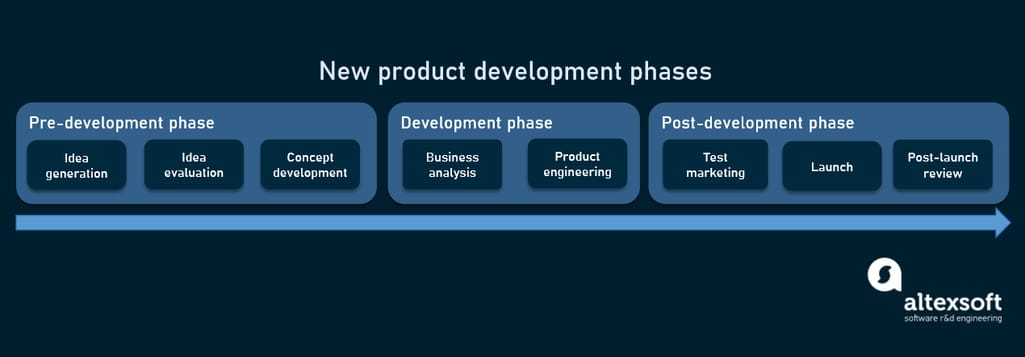
Phases and steps of an NPD process
For more clarity, we’ll illustrate the journey of a product from idea to market using the example of Airbnb, a home-rental unicorn startup founded in 2008 by 27-year old roommates Brian Chesky and Joe Gebbia. Currently, in 2019, the peer-to-peer lodging service boasts over 7 million accommodation options in more than 100,000 destinations around the world and its estimated value is roughly $35 billion.
Pre-development / ideation phase
Every innovation or improvement to an existing product starts with an idea. The bad news is that brilliant ideas rarely appear from nowhere. The probability of creative lightning suddenly striking you is about zero. The good part of it lies in the fact that modern businesses can utilize all the power of idea management or ideation — a set of tools and practices to capture, assess, and develop ideas in a systematic way.
The ideation phase is also known as the fuzzy front-end (FFE), a less formal nature of the pre-development stage involving creativity and inspiration. By whatever name you call it, the stage includes three steps: idea generation, idea evaluation, and concept development and testing.
Idea generation
The first step of ideation occurs long before your potential product comes to fruition. It all begins with spotting market gaps or discovering opportunities to improve your existing offerings and processes.
The ideas can be collected from different sources: marketing research aimed at discovering customer needs and shifts in their preferences, internal brainstorming sessions, analyzing new successful technologies offered by competitors, and social media surveys, to name a few.
A popular brainstorming technique to produce new ideas is SCAMPER, initially developed as a method to boost student creativity. Currently, it is widely used by companies to improve or change their existing offerings. The acronym SCAMPER stands for Substitute, Combine, Adapt, Modify, Purpose, Eliminate, Rearrange / Reverse. Each verb prompts you to rethink your product or service by answering a sequence of questions that can be formulated as follows:
Substitute — Which features can be replaced to make your product better?
Combine — How do you combine your technology with something else to extend its functionality?
Adapt — Can you adapt this product to other customers and markets?
Modify — What can you add to change this product?
Purpose — Can you use this product in some other way?
Eliminate — Which features can be removed to make the product cheaper, faster, lighter or simpler?
Rearrange / Reverse — Can the product evolve into something new? What if you turn it upside-down or inside-out?
SCAMPER is only one of tons of techniques for enhancing creativity, from mind maps for visualizing and organizing ideas to idea contests among employees that encourage innovation across the organization. Usually, the key to success lies not in a particular method, but in collaborative work attracting different people (and different visions).
To engage more participants in collective brainstorming, you can utilize idea management software, equipped with mind map templates, built-in video and text chats, tools to upload images and documents, and other useful functionality. Examples of such solutions are the infinite virtual whiteboard Miro, the intuitive mind mapping app iMindQ, and mind map editor for brainstorming MindMeister. Often, idea management applications also offer tools for basic idea evaluation.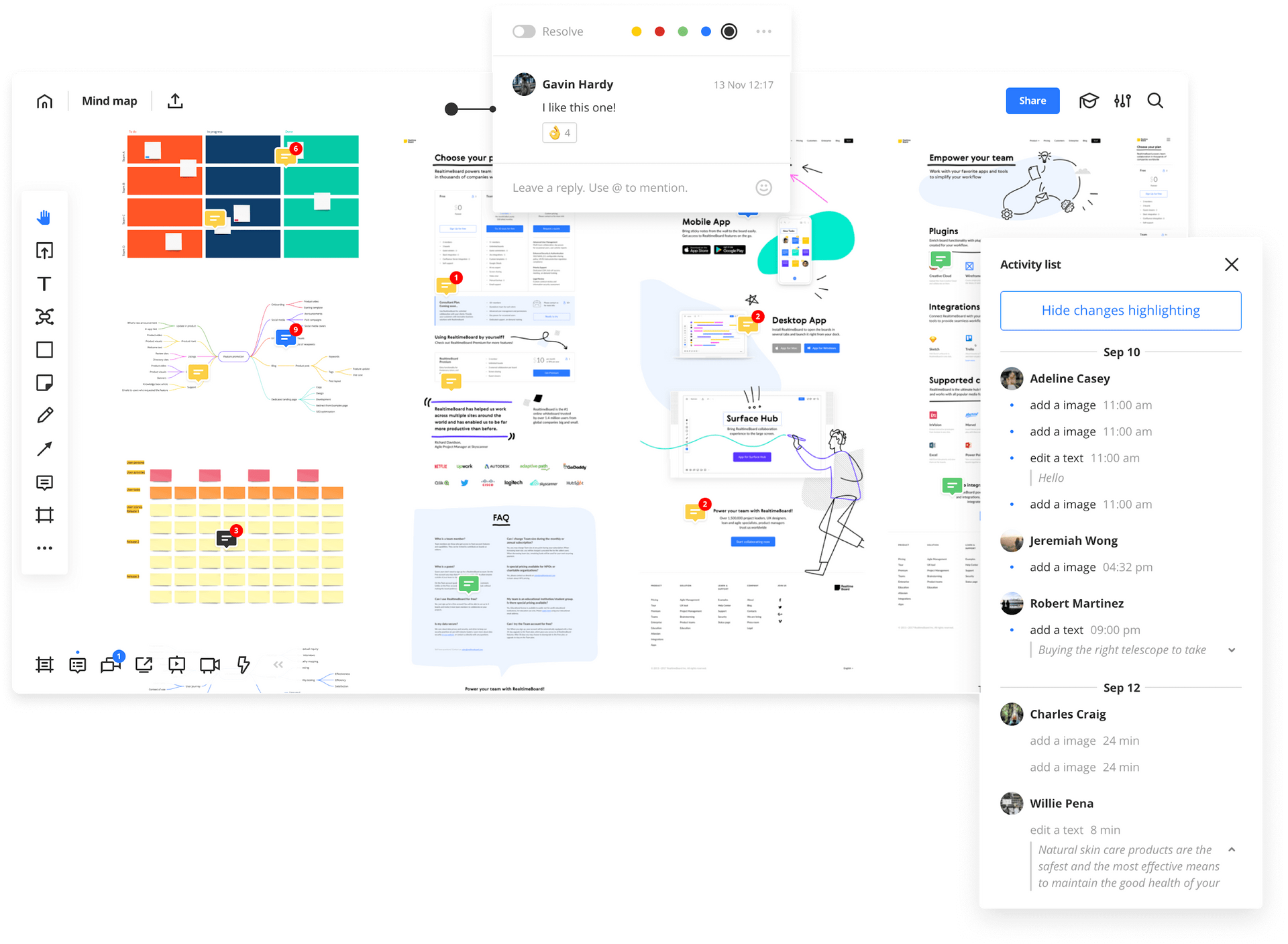
Infinite whiteboard for team collaboration. Source: Miro
Airbnb idea generation. The idea of peer-to-peer accommodation services was born out of vital necessity. Back in 2007, Jobless roommates Brian Chesky and Joe Gebbia ran out of cash and couldn’t pay their rent in San Francisco. Luckily for them, the city was about to host a big design conference and all hotel rooms were booked in advance. So the duo decided “to make a few bucks” by offering visitors a bed and breakfast in their loft. They bought three air mattresses, made a simple website, and so it all started.
Idea evaluation / screening
After ideas are generated, a business should decide which of them will work best and which are not worth investing in. This is the very first of many screening points new products go through, and its main goal is to reject poor ideas, those not aligned with the company’s objectives, and thus prevent wasting money on unprofitable projects.
Here are some popular techniques used to select and rate ideas.
Pass-fail evaluation is applied when you need to sift through hundreds of ideas and reduce their number to form a manageable pool. Each initiative is checked against a set of important criteria such as compliance with company culture and strategy, feasibility (or availability of proper knowledge and technology to develop the idea), budget acceptability, and more. Ideas that don’t meet basic requirements are cast away; those satisfying all criteria move forward.
Actually, if you initially have just a few ideas, you can omit this step of evaluation and switch straight to more sophisticated methods of idea scoring.
Evaluation matrix is a simple rating scale prompting experts to evaluate how well the idea meets different criteria. The matrix lets you compare ideas by each criterion as well as by the total score, giving you a clear review of competitive concepts.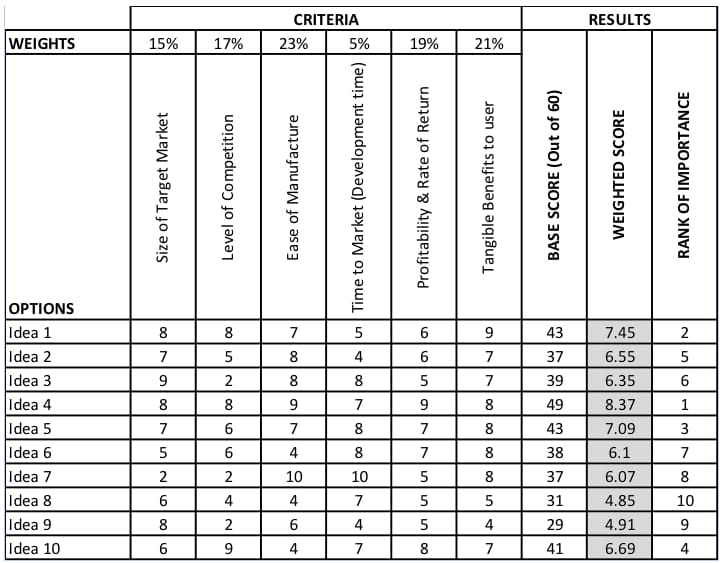
An example of an idea evaluation matrix using a scale 0 to 10 points for each criterion. Source: QualityInspector
After identifying the most promising ideas you can perform a more detailed financial and value analysis.
Preliminary financial analysis is made by experts to estimate development costs and potential gains of a new product. While at this stage there are too many financial unknowns, you can at least avoid too costly solutions.
SWOT analysis is another well-known technique for assessing a product’s Strengths, Weaknesses, Opportunities, and Threats. We’ve already described this method in several previous posts — for example, in our article about Minimum Viable Product.
CO-STAR is a customer-centered framework to get a handle on the additional value created by your innovation. When considering a new product idea, your company team should find clear answers to the following questions:
- Who is the Customer?
- What is the Opportunity?
- What is your Solution?
- Who should be on the Team?
- What is your competitive Advantage?
- What are the expected Results?
The more detailed and persuasive the answers, the higher the chance of success.
CO-STAR framework for Airbnb. As far as we know, Brian Chesky and Joe Gebbia didn’t apply the CO-STAR method to evaluate their initial idea. So, let’s do this job for them.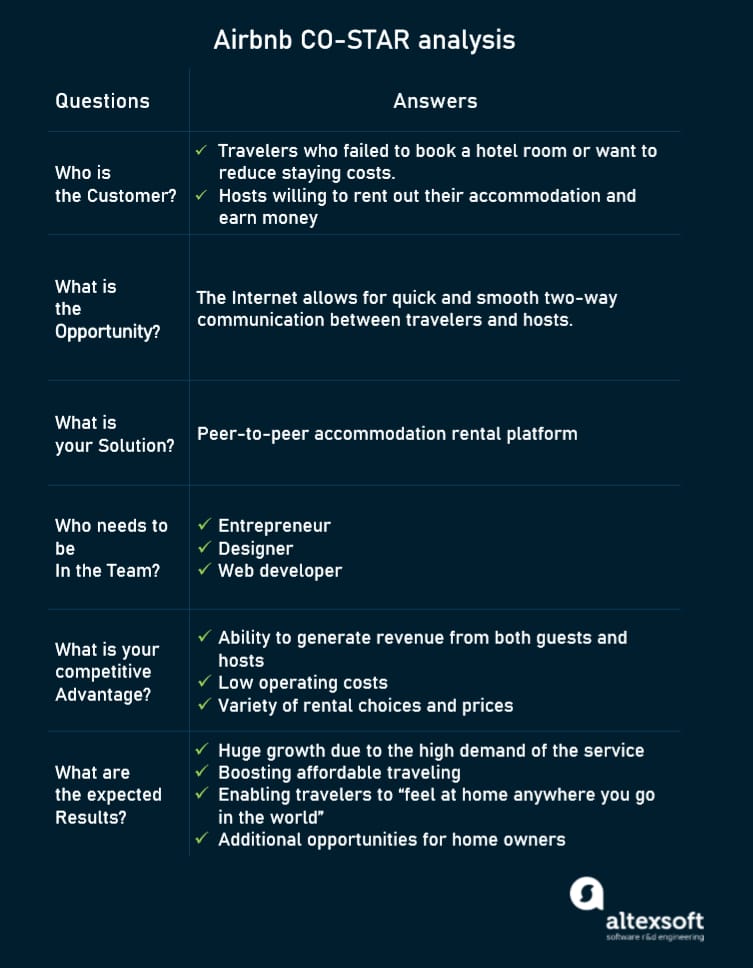
CO-STAR framework for Airbnb
Concept development and testing
The final step of the ideation phase helps you understand whether customers really need your innovation. To prove its viability, you should develop a new product concept or a detailed description of the idea from the customer’s point of view. This is often included in a product requirements document (PRD). The concept reflects the core benefits of a new solution in terms of:
- price,
- convenience,
- usability.
- performance,
- quality, and
- functionality.
When the detailed description is ready, you should take it to targeted customers. Concept testing usually involves opinion polls conducted among potential users. By reaching out to them with the detailed product description, you can prove it viable or, vise-versa, reject it as not workable (at least currently). The survey will also help you better understand the expectations of real customers and make improvements to increase the chances of achieving product/market fit.
Airbnb concept development and testing. The co-founders tested their idea with the first three guests who paid $80 each to sleep on the air mattresses. That's how the entrepreneurs verified the existence of customers ready to use this new type of service. However, it took them another two years to perfect their concept before they could raise first funding ($20,000) from investors.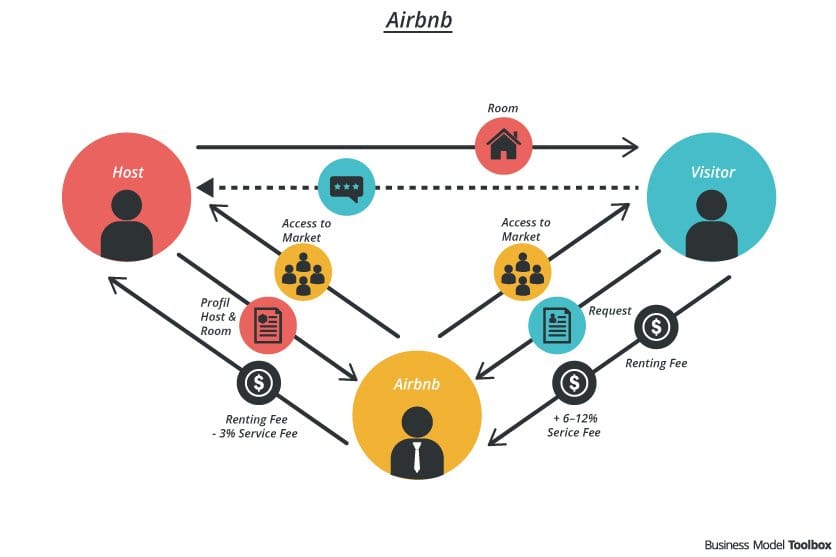
AirBNB working concept. Source: Business Model Toolbox
Development phase
At this phase, a pure idea becomes a real thing targeting a real audience and promising real revenue. To add more value to the innovation, a product development team works hand in hand with a product management team and marketing department. All these units align their efforts with a clear product vision established across the business.
Business analysis and marketing strategy
A concept that survives an ideation phase should be studied from the business point of view. Will the new product be profitable? How much will it earn? What will development and promotional expenditures be? These and other questions are addressed to a business analyst whose responsibilities include eliminating wasteful ideas and preventing unnecessary costs.
Another document that provides insights into customer needs and informs the business strategy is the market requirements document (MRD). Learn about it in our dedicated article.
A detailed business analysis gives you valuable information about:
- the selling price of your product (including the minimum sale price),
- product market potential,
- the break-even point (sales volume or price required to cover development and marketing costs),
- expected sales volume and revenue, and
- the lifespan of your product on the market.
If the business analysis proves the profitability of your innovation, it’s time to start moving it from concept to customer — in other words, to build a product marketing strategy, that, among other things, defines a clear product vision, and helps you determine how to position the new offering on the existing market.
Airbnb marketing strategy. Throughout Airbnb’s history, the company has reshaped its product vision several times. And, that resulted in changing the marketing strategy. Initially, they targeted guests of large conferences and festivals offering them “air bed and breakfast” in shared rooms.
During Barack Obama’s 2008 election campaign, they developed the marketing concept “Obama supporters hosting Obama supporters.” But, the success was short-term. Things got better when the company started offering all types of lodging instead of focusing on shared spaces and then simplified their name the Air Bed & Breakfast to Airbnb.
Product engineering
Product engineering is a process of designing, developing, and testing a new product or feature. This step involves a product development team supervised by a project manager who tracks progress, keeps the process within budget, and, in the ideal world, guarantees on-time delivery.
If you still confuse this position with a project manager, our article comparing product managers vs. project managers will help you grasp the difference between the two. In short, a project manager oversees the product creation, while a product manager develops and coordinates the product roadmap that encompasses and links up different steps of the new product development process.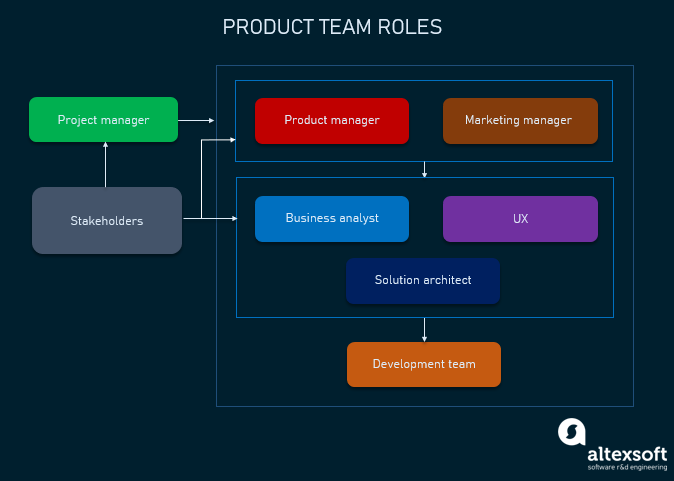
Roles in product management
Before release, the software product undergoes strict quality control procedures to eliminate flaws, ensuring its effectiveness and performance. You can read our article about the basics of software quality management to better understand the principles of quality assurance, quality control, and testing.
Airbnb product engineering. At an early stage, the Airbnb team consisted of two co-founders, both with a degree in industrial design. They had a product vision but needed a technical skill to create something better than a low-quality website. In 2008, Brian Chesky and Joe Gebbia invited Nathan Blecharczyk, software engineer and Harvard graduate, to become the third co-founder. Nathan built the original website using Ruby on Rails open-source framework.
Currently, hundreds of engineers worldwide are working on maintaining the platform and developing new services. They use a range of technologies including Ruby, Java, Kotlin, JavaScript, Swift, and React.
Post-development / Introduction phase
Once the working version of the product is complete, it enters post-development, the last phase, that has three steps: test marketing, commercialization (launch), and post-launch review.
Test marketing
First, the new product or its prototype is introduced to a very small market to collect feedback and understand what should be improved before a full-fledged launch. In this step, the company can conduct user acceptance testing, also called end-user testing or validation — a type of quality assurance activity we described in detail in an earlier blog.
After test marketing, you may need to modify some features or design elements to make your product more useful and attractive in the eyes of your targeted users.
Airbnb test marketing. Airbnb tested their site with end users time and again. The product underwent a lot of transformations, working its way from a simple platform with zero bookings to a global online marketplace with 2 million travelers using its services each night. One of their early technical solutions approved by end users was redesigning the website around the idea of quick booking that takes only three clicks.
Commercialization
After test marketing, the company can finally concentrate on a large-scale launch of the new product in the mass market. This step is no less important than generating a unique idea or development of a potentially game-changing technology.
The introduction of your unique solution needs to grab the attention of as many people as possible. Three aspects are critical for launch success:
- customer awareness. Support the introduction with advertising, direct social media or email marketing campaigns, and other promotional. efforts that help you build excitement around your offering.
- competitive pricing. Determine the price based on covering cost and what the market will bear.
- proper timing. To pick the best time for kicking off your product, consider your schedule, launches by your competitors, and user readiness to adopt your solution. However, you can’t predict and control everything. Once the launch date is announced, try to stick to it.
Airbnb launches. As you probably remember, the first Airbnb launches were timed to coincide with large conferences to take advantage of the huge increases of tourists. However, in spite of smart timing and budget prices, the company failed to attract many customers.
To a great extent, the low interest was caused by a lack of awareness and trust. So, at a later stage, the company focused on brand advertising, building trust with both hosts and guests, and making their platform secure. Currently, Airbnb offers host protection insurance and its website has a page dedicated to safety measures the company takes to mitigate fraud risks.
Post-Launch Review
A new product development process doesn’t end with the launch. You can improve its performance on the market and learn important lessons by doing post-launch reviews. Companies are recommended to conduct the first audit somewhere between one and six months after commercialization.
Assessing of financial data, customer satisfaction, and other available information will reveal the strengths and weaknesses of the product as well as of the entire NPD process. What can you do to make the existing product better and more appealing to customers? How can you enhance the effectiveness of product development for your next innovation? What new ideas can be generated from this experience? Detailed answers to these questions will drive your business forward.
Airbnb post-launch reviews. The company is constantly learning from its mistakes and experiences. Thanks to this approach, they have been on the rise since 2009. For example, one such review revealed that listings that came with high-quality photos gained two to three times more bookings by the end of the month. Now Airbnb hires professionals to take pics of their properties.
Other models of new product development
Not only products, physical or digital, need continuous upgrading to meet changing customer needs — so does the product development process itself. In addition to the stage-gate model, designed back in the 1980s, new approaches have appeared to address new challenges. And though a majority of businesses still stick to the system in their innovation activities, there are alternatives that allow for reducing development time and expenses.
Product development lifecycle model
The term product development lifecycle (PDLC) is often applied to innovations that include both hardware and software components.
By contrast with the software development process that refers to designing, developing, and testing software solutions, PDLC encompasses all stages of bringing a digital product to market. The major steps of PDLC first introduced by Sandia National Laboratories in their 2015 report are:
- Requirement specification for the product under development,
- Designing,
- Manufacturing for hardware and development for software,
- Testing,
- Distributing,
- Using and maintaining,
- Disposing (recycling, disassembling or destroying for hardware and uninstalling or deleting for software).
Lean startup approach
Lean approach, especially popular among software development companies, was borrowed from the Toyota Production System (TPS), a manufacturing philosophy that focuses on eliminating waste and thus creating more customer value.
In terms of lean software development, the major waste a company should address is:
- unnecessary features and functionality,
- starting more that can be completed,
- delays in the development process,
- unclear requirements,
- bureaucracy,
- ineffective communication,
- partially done work,
- quality issues, and
- switching between tasks.
Cutting waste helps companies realize another basic principle of the lean approach known as deliver fast. You bring customers a simple solution as quickly as possible, and then continuously enhance your technology based on their feedback.
A process that never ends
But let’s come back to the Airbnb example. Having begun by disrupting the hospitality industry, it keeps coming up with innovative ideas on its platform. Over the past ten years, they launched a range of new products including:
- Price Tips — a pricing recommendation tool,
- Airbnb Plus — a collection of high-end accommodation options that meet a 100-point quality checklist. The average rate for Airbnb Plus is around $200 per night — instead of the usual $80-100 charged by hosts from the standard listing.
- Airbnb Experiences platform — a feature that allows guests to dig deeper into the local culture by taking part in different activities, from cooking classes to yoga sessions.
The Airbnb story tells us that a product development process should never end as perfection is never actually achieved.
Another lesson is that a new product should be associated with a big idea that resonates with your customers. Here’s how Brian Chesky, Airbnb’s co-founder and CEO, put it on the company’s website,“We asked ourselves, 'What is our mission? What is the big idea that truly defines Airbnb?' Really, we're about home. You see, a house is just a space, but a home is where you belong.”
“Belong Anywhere” is Airbnb’s slogan known worldwide. It’s time to create your own.
For more information about other processes, practices and methodologies associated with product development, read our previous articles:
Product Development Workshop
Business Model Canvas
Continuous Delivery and Integration
Software Business Models
25 Scrum Process Best Practices
Agile Project Management

